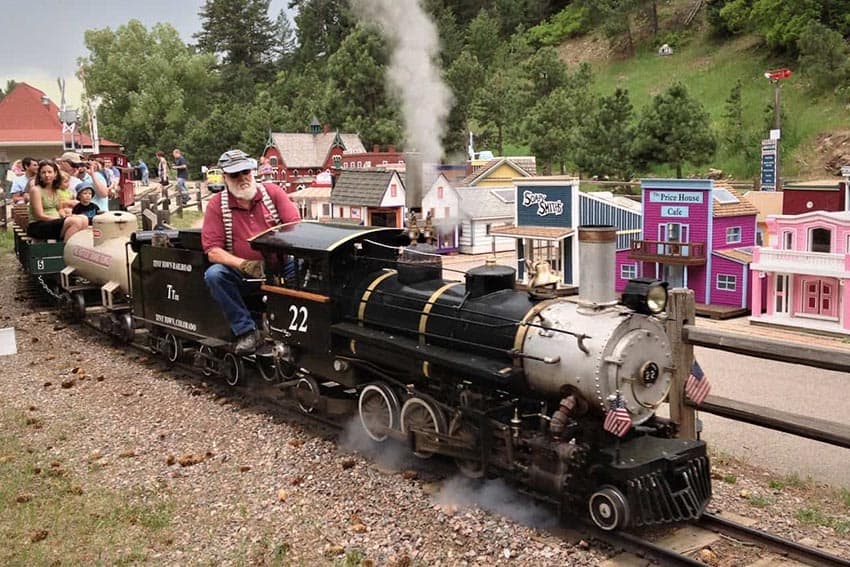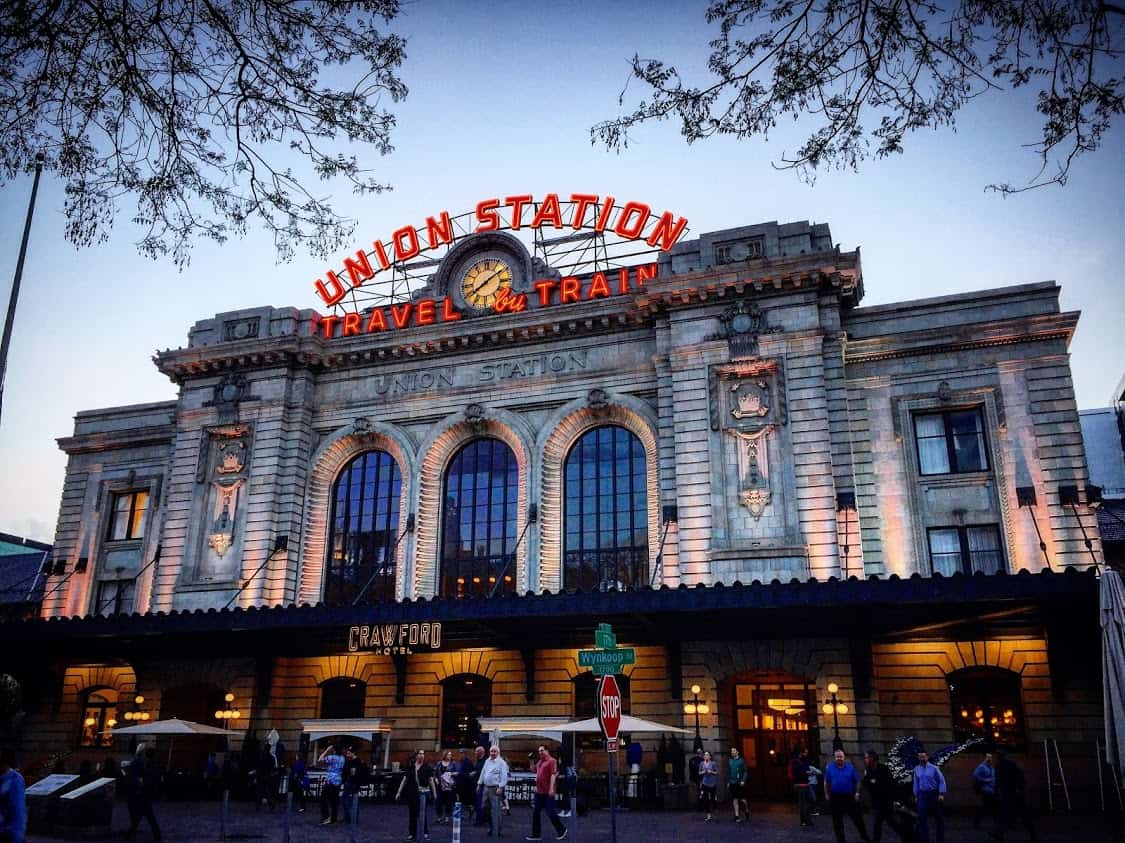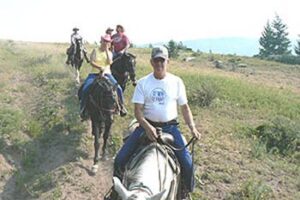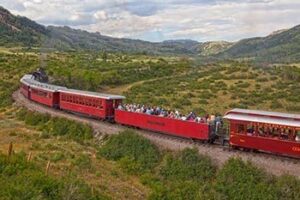
A Guide to Riding the Narrow Gauge Railroads of Colorado and New Mexico
By Rich Grant

The Rocky Mountains of Colorado and New Mexico are home to some of the most colorful and picturesque narrow gauge steam railroads in the world. You have many choices for riding the rails in Colorado.
Their fame is international. Walk into any model railroad shop from England to Germany, and there are shelves filled with miniature Colorado trains.
The railroads have been romanticized in movies from Butch Cassidy to Indiana Jones, and attract rail buffs who come West to live by the words of poet Edna St. Vincent Millay:
My heart is warm with the friends I make,
And better friends I’ll not be knowing;
Yet there isn’t a train I wouldn’t take,
No matter where it’s going.
And it’s where these trains go that make them so special. Following the discovery of gold and silver in the Rockies in the 1880s, narrow-gauge railroad lines were built up nearly every canyon and high pass, making them the lifeline to mining communities and towns along the way.
At one point, more than 2,000 miles of narrow gauge track probed the mountains, curling along river banks, burrowing through sheer rock walls, and steaming over trestles.
Through the efforts of states, historical societies, and private individuals, many of these incredible steam trains still exist. For those with smoke, steel, steam, and fire in their blood, here’s ultimate Rocky Mountain “bucket list” train trip.
Denver

It was the railroads that changed Denver from a wild frontier town to the largest and most sophisticated city between St. Louis and San Francisco. Today, Denver still loves its trains.
The restored downtown Union Station has become the ‘living room’ of the Mile High City with dozens of bars, breweries, fine dining restaurants, hotels and shops within a few blocks of the station, or in the massive lobby built in 1914.
There is direct rail service from Denver International Airport to Union Station with trains leaving as often as every 15 minutes.
You can also catch AMTRAK here for daily trains to Chicago or San Francisco, with trains on weekends during ski season to Winter Park Ski Resort passing through 28 tunnels on the way.

Colorado Rail Museum
Nestled between high rocky buttes just 12 miles west of Denver, you’ll find the state’s largest collection of railroad stuff, including locomotives, historic photos, cars, and cabooses.

Most fun of all, the museum has a half-mile circle of narrow gauge track – like a giant’s model train set — allowing monthly “steam-ups” for their fleet of authentic steam locomotives.
On steam days, the trains circles three times every hour, providing hundreds of photo opportunities to catch locomotives in action.
Events include a Polar Express that runs throughout the holiday season.
On weekends without steam, the museum runs the equally fun Galloping Goose, a crazy contraption of a 1920s Pierce-Arrow Limousine on wheels with a bus welded on the back. The vehicle was actually used to run mail and passengers over Lizard Head Pass near Telluride.

In the basement of the museum is one of Colorado’s largest HO model railroads — more than 20 years of work in an area 45 feet long with a circus, mountain passes, and full cities, much of it recreating a cross-section of the state’s most interesting railroads such as those at Cripple Creek and Tennessee Pass.
A giant outdoor garden railroad offers electric model trains traveling through cultivated forests of miniature trees and buildings. www.coloradorailroadmuseum.org
Tiny Town Outside of Denver
This little village was constructed in 1915 at the site of an old stagecoach stop just outside of Denver when George Turner began erecting one-sixth sized buildings for his young daughter.

In 1920, the town was open to the public and in just five years it became one of Colorado’s top five attractions.
In 1939, a miniature railway was added, but a flood, a fire and changing economic conditions forced the attraction to close.
But then in 1988, volunteers began the resurrection of Tiny Town. Today, more than 100 colorful buildings are in place, all beautifully hand-crafted with wonderful details, many with full interiors.
Some of the buildings are exact replicas of famous structures from Colorado’s history, but all fit the character of a Colorado village at the turn of the century.

The one-sixth size village is circled by the miniature tiny town steam railway, a mile-long run with open-air cars pulled by an authentic steam locomotive similar to the narrow gauge locomotives that once worked the mountain lines of Colorado.
Passengers board the small train for a ride over a trestle and through tall pine trees.
Forney Transportation Museum

This one-of-a-kind collection began with antique cars but soon expanded to include vehicles of all kinds. One of the main reasons to visit is to stand beside one of the seven last remaining Big Boys in the world — the largest steam locomotive on the planet.
The Union Pacific has just restored a Big Boy and it is currently touring the country.
If fate doesn’t let you catch up with a Big Boy at a rail show, you can always see the one in Denver. www.forneymuseum.com
Caboose Hobbies
Caboose Hobbies (one of the largest model railroad stores in the nation) is a virtual supermarket of trains with all scales and sizes as well as operating miniature railroads and memorabilia, books, videotapes and more. It is located just outside of Denver, near I-70 heading up into the mountains. www.caboosehobbies.com
The Georgetown Loop Railroad
This a reconstruction of one of the most famous engineering feats in railroad history. Originally in 1877, a railroad ran from Denver 42 miles west to the silver mining town of Georgetown.
Because there was more silver just two miles away in Silver Plume, they decided to push the railroad up the valley.
The challenge? Silver Plume was 600 feet higher in elevation. To gain that much altitude that fast, the railroad had to twist and turn four and a half miles, making two and a half complete circles and at one point crossing over itself like a corkscrew on a 90-foot-high trestle –the Devil’s Gate Bridge.
With the collapse of the mining industry, the railroad was closed and in 1939 torn up for scrap metal. For 35 years the grade lay undisturbed, but then the Colorado Historical Society bought it and steam returned to the valley in 1975. Today, steam-powered locomotives make the climb up the valley daily in summer months.
The train may be boarded in Georgetown or Silver Plume and offers panoramic and often scary views, particularly when crossing the bridge. From the open-air viewing cars it is possible to see bighorn sheep and other wildlife, but it is the sound of the train whistle echoing down the valley that is unforgettable.
There are wine trains and an optional tour of the Lebanon Silver Mine along the way. The railroad is located in Georgetown, 42 miles west of Denver on I-70, exit 228. In town, the Old Georgetown Station has exhibits and a railroad gift shop. www.georgetownlooprr.com/

Cumbres & Toltec Scenic Railroad
Built in 1880 as part of the Denver & Rio Grande Western, San Juan Extension, this was the main line from Denver to Durango and all the gold and silver in the San Juan Mountains.
The railroad never ran anything except steam locomotives, but in 1970, this American treasure was in danger of closing. Instead, the states of Colorado and New Mexico stepped up and purchased it. They continue to run it as a historical museum — a National Landmark that moves.
And move it does. It is America’s longest (64-miles each way) and highest (10,015 feet) operating narrow gauge steam railroad.
Coal powered steam locomotives leave daily from Antonito, Colorado and Chama, New Mexico, rolling through the high-country and forested slopes of the San Juan range and San Luis Valley, passing through groves of pine and aspen, crossing the spectacular 10,015 foot high Cumbres Pass, curling along the lip of 700-foot deep Toltec Gorge, and steaming through tunnels and over trestles along the Los Pinos River.
The readers of USA Today have twice voted this (most recently in May 2019) to be the “best train ride in America.”
There are nine different ticket options that allow passengers to board in either Antonito or Chama and have a delicious hot lunch nearly two miles above sea level at Osier Station mid-way. Passengers can then return to their cars by train or at the completion of the 64 mile trip by motorcoach.
The railroad has been featured in many films, including “Indiana Jones and the Lost Crusade” as well as most recently in “Hostiles” with Christian Bale and A Million Ways to Die in the West” with Seth MacFarlane.
It’s located 30 miles from Alamosa, CO, or about an hour from Taos, NM or Pagosa Springs, CO. www.cumbrestoltec.com
Durango & Silverton Narrow Gauge Railroad

Train excursions leave daily from the popular tourist town of Durango in southwestern Colorado, traveling through the San Juan Mountains to Silverton, passing through areas accessible only by rail. The experience includes a railroad museum in Durango, coaches, open gondolas, a parlor car, and diesel and steam-powered narrow gauge locomotives.
Five trains operate during the peak of the season from early May to late October. A variety of ticket options include lunch breaks in the historic mining town of Silverton, and it’s even possible to buy one-way train tickets and get off in Colorado’s backcountry for river rafting, climbing and hiking 14ers, and then re-board the train days later to come home.
The railroad has been featured in numerous films, including the classic, “Around the World in 80 Days.” www.durangotrain.com
Riding the Rails in Colorado Update
On July 2, 2019, the federal government charged the Durango & Silverton railroad with starting a forest fire last year that burned 54,000 acres. The government is suing the railroad for $25 million for damages and the cost of containing the fire. Since 2018, the railroad has spent $7 million in upgrades to make the trains safer and less likely to start fires. While the lawsuit continues with insurance companies, it should have no impact on daily schedules.
But of course, since we are talking about 19th-century railroads, it’s always best to confirm schedules for any of Colorado’s steam train rides by checking their official websites.
- Galveston’s Horrible History - August 15, 2024
- Oklahoma City and the Protest Movement - February 15, 2024
- California, We Still Love You - August 31, 2023






Good story on the the trains in CO. I did two of them. Thanks